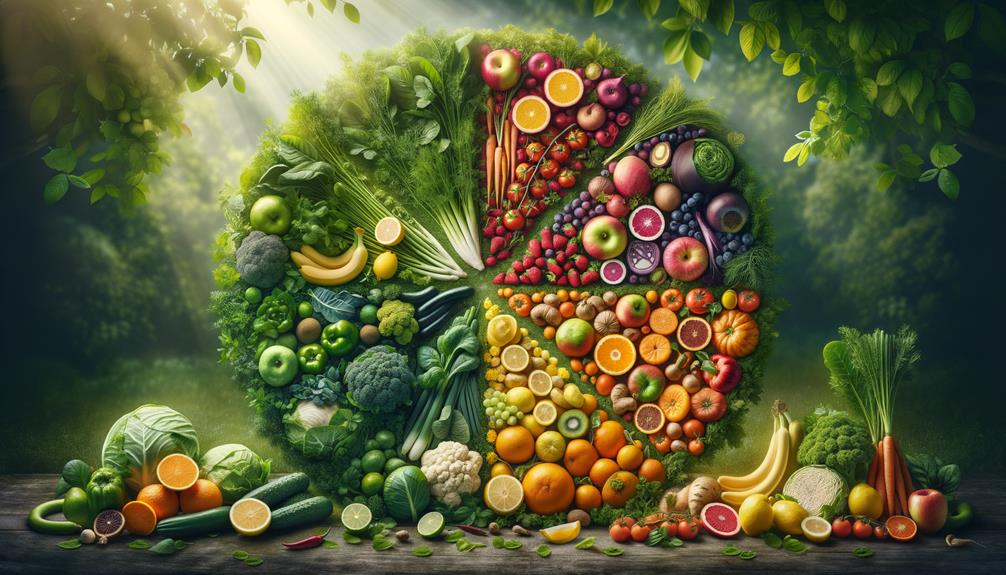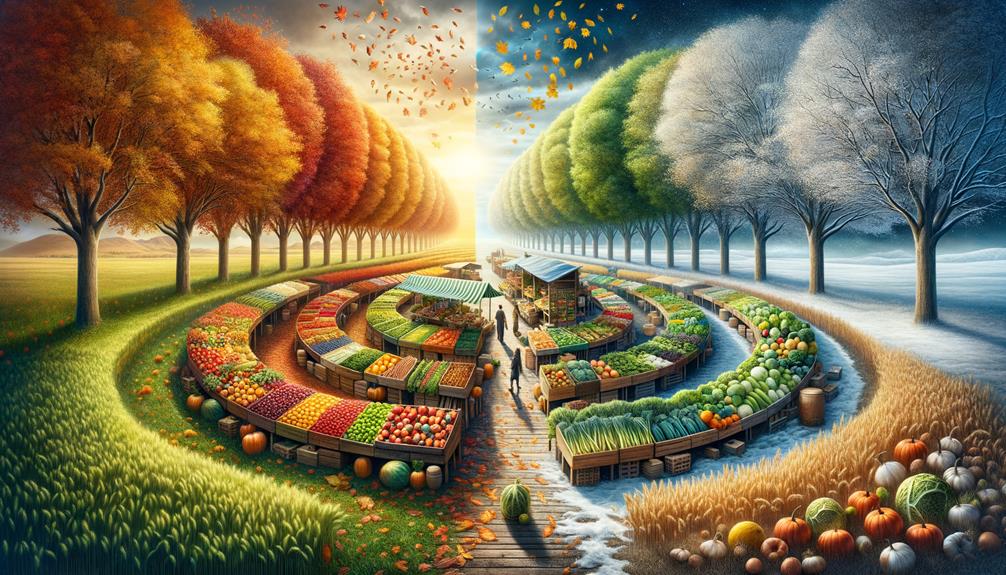I've always found that eating seasonally enhances the flavor and nutritional value of my food. When I buy produce in season, I get fresher, chemical-free options that are packed with vitamins and minerals. This approach also supports local farmers and reduces the carbon footprint, making it a more sustainable choice. To get started, I research what's in season, visit farmers markets, and try out new recipes. Growing my own food has also deepened my connection to what I eat and provided even fresher, nutrient-dense meals. If you're interested in maximizing the benefits of seasonal eating, there's a lot to learn.
Key Takeaways
Seasonal diets prioritize consuming fruits and vegetables when they're at their freshest and most nutritious. By incorporating a diverse range of produce throughout the year, aligned with natural growth cycles, you can experience new flavors and textures. Eating seasonally also has a positive impact on local farmers and the environment, as it reduces the carbon footprint associated with transportation. To make the most of seasonal produce, many people enjoy exploring new recipes and preserving fruits and vegetables for year-round use. If you have the means, growing your own food can further enhance sustainability and ensure you have access to fresher, more nutrient-dense meals.
Understanding Seasonal Eating
Seasonal eating is about enjoying food at its peak flavor and nutritional value. By focusing on eating seasonally, I synchronize my diet with the natural cycles of growth and harvest. This approach ensures that the fruits and vegetables on my plate are as fresh as possible. The changing seasons dictate what produce is available, providing a diverse range of nutrients throughout the year.
In the spring, I savor fresh produce like asparagus, rhubarb, and spinach. Summer brings tomatoes, cucumbers, and melons. By eating these seasonal fruits and vegetables, I not only enjoy their peak flavors but also support sustainable practices.
Eating what's in season means I'm consuming food that hasn't traveled far, reducing my carbon footprint. This approach also connects me to traditional practices, where people relied on the natural ebb and flow of harvest cycles.
Understanding these cycles helps me make informed choices about my diet. Whether it's a crunchy cucumber on a hot summer day or a tender spinach leaf in the spring, eating seasonally means my meals are fresher, tastier, and more in harmony with nature.
Health Benefits

When I eat in-season produce, I get the most nutritional bang for my buck while supporting a healthier environment. Since fruits and vegetables are picked at their peak, they're packed with more vitamins and minerals compared to out-of-season options that may require longer storage or transportation.
Eating in-season produce has a significant upside – it's higher in nutrients. When fruits and veggies are harvested at their best, they retain more of the good stuff, which can really benefit my overall health. For example, summer berries are rich in antioxidants, while winter squash is a great source of fiber and vitamins.
Another perk of in-season produce is that it tends to be grown without added chemicals, making it a cleaner choice. This reduces my exposure to pesticides and preservatives, promoting a healthier diet. Plus, it's often cheaper, so I can enjoy a variety of fresh foods without breaking the bank.
Environmental Impact

When I opt for in-season produce, I'm making a conscious effort to reduce my carbon footprint. By choosing locally grown foods, I'm minimizing the greenhouse gas emissions that come with long-distance transportation. This approach not only conserves natural resources but also ensures the produce is fresher and potentially cheaper.
By embracing seasonal eating, I'm contributing to a healthier environment. Buying locally grown, seasonal foods supports small farmers and promotes food diversity in my community. This encourages sustainable agricultural practices that rely less on harmful chemicals and fertilizers, which in turn preserves local ecosystems and biodiversity.
Prioritizing seasonal eating is a simple way for me to make a positive impact on the environment without drastically changing my lifestyle. By focusing on seasonal produce, I'm making a deliberate choice to reduce my carbon footprint and support a more sustainable food system.
Getting Started

Starting to incorporate seasonal eating into my diet means researching which fruits and vegetables are in season in my region. This step is crucial to making informed choices about in-season produce. By focusing on what's naturally available, I can mix up my meals with a variety of cool-weather produce I might not typically consider. This variety not only enhances my diet but also supports an eco-friendly approach to eating.
Seasonal eating requires changing my shopping habits. I make it a point to visit local farmers markets regularly to source fresh, in-season produce directly. Online resources also come in handy for finding new recipes that feature seasonal ingredients. This exploration helps me adopt a simple, healthy lifestyle without feeling overwhelmed by significant changes.
Preserving in-season produce through methods like canning or freezing is another practical strategy. This way, I can still enjoy my favorite fruits and vegetables even when they're out of season, maintaining a balanced diet year-round. By taking these small steps, I can smoothly shift into a seasonal eating lifestyle that frees me from processed foods while contributing positively to the environment.
Growing Your Own Food

Growing my own food deepens my connection to what I eat and encourages a more sustainable lifestyle. When I cultivate my own garden, I control what I consume, ensuring it's fresh and naturally grown. Even in urban areas, gardening in small spaces with containers makes this accessible.
To succeed, I need to consistently nurture, water, feed, and compost my garden. This hands-on involvement helps me appreciate the effort behind each meal, making me more mindful of my dietary choices. By growing my own food, I'm less reliant on commercially farmed goods, which often travel long distances, reducing my carbon footprint.
My garden attracts biodiversity, creating a balanced ecosystem that supports my health and nutrition. The act of gardening itself is therapeutic, reducing stress and promoting physical activity, essential for overall wellbeing.
When I grow my own food, eating seasonally becomes natural. I adapt my diet to what my garden yields, resulting in fresher, more nutrient-dense meals. This practice not only improves my health but also promotes sustainable consumption patterns, supporting an environmentally friendly approach to food and nutrition.
Frequently Asked Questions
What Do You Eat in Different Seasons?
I enjoy seasonal foods. In spring, fresh asparagus and spinach are my go-to choices. When summer arrives, I crave juicy tomatoes and sweet melons. Fall is the time for pumpkins and crisp apples. During winter, I turn to hearty root vegetables like carrots and potatoes.
How to Adapt Your Diet for Different Seasons?
To adapt my diet for different seasons, I focus on eating produce that's available locally and in season. I research what's available in my area and incorporate seasonal meats or fish into my meals. I also use preservation methods like canning and freezing to enjoy my favorite fruits and vegetables year-round.
How Does Seasonal Variation Affect Nutritional Health?
Seasonal variation affects my nutritional health by changing what I eat and how much I weigh. In winter, I tend to consume more calories and fat, which can impact my body's chemistry and measurements, making it necessary to be mindful of my diet throughout the year.
What Are Seasonal Foods?
Seasonal foods are the freshest, tastiest fruits and vegetables, picked at their peak. Since they vary by region and time of year, they encourage a diverse and nutritious diet. By eating seasonally, we support local economies and reduce our carbon footprint.



